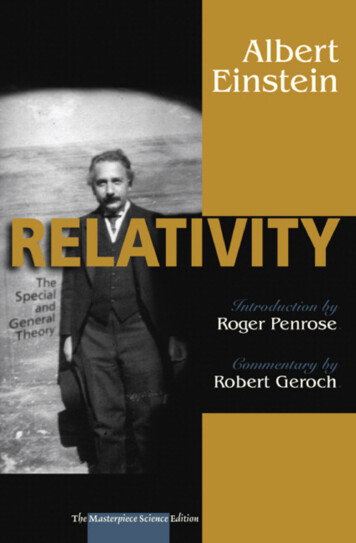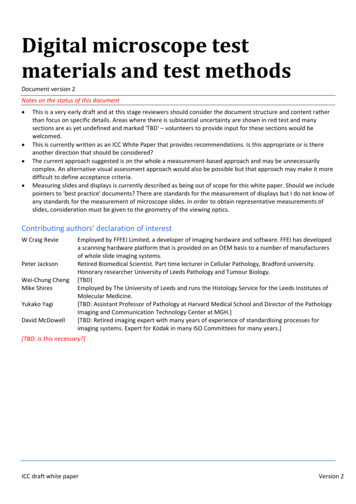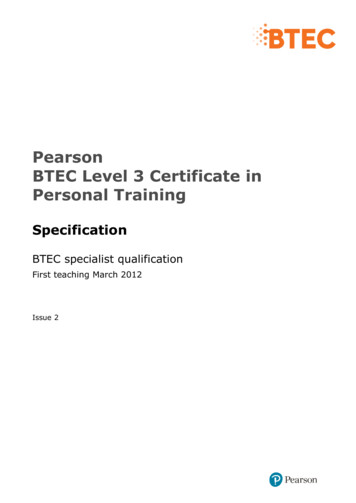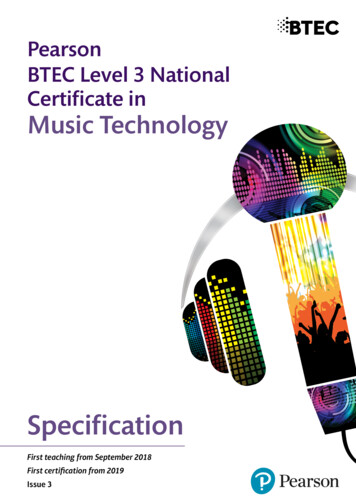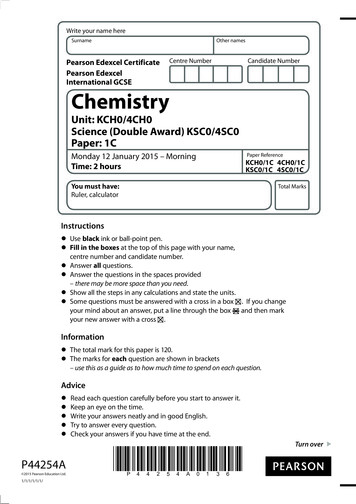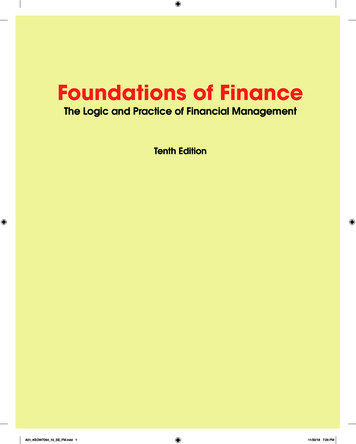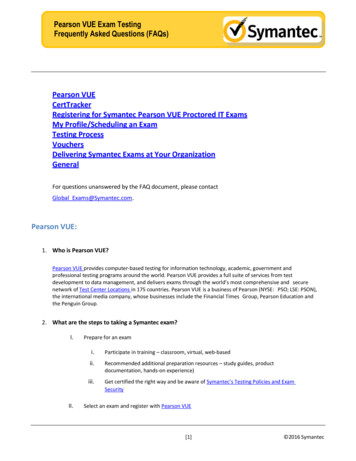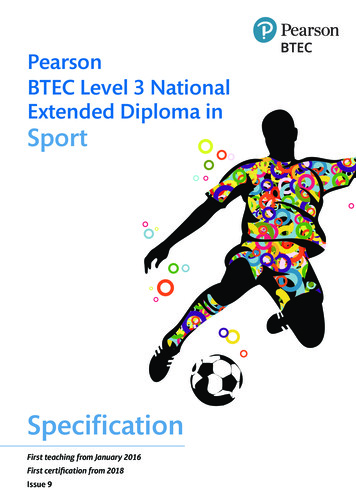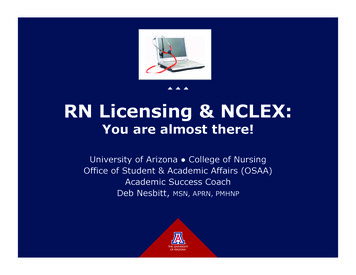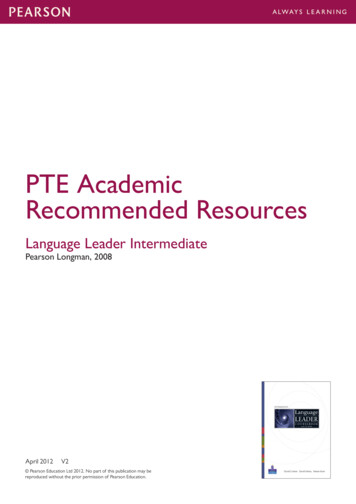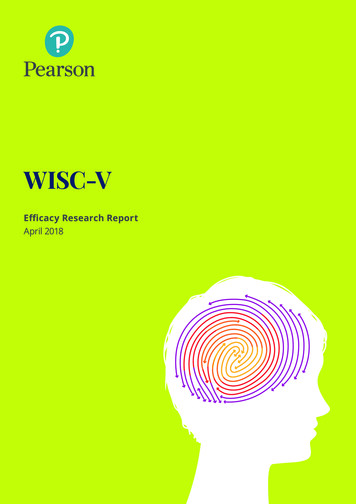
Transcription
WISC -VEfficacy Research ReportApril 2018Efficacy Research Report WISC-V1
Contents03Introduction05Product summary07Assessment quality indicators08Foundational research09Product researchEfficacy Research Report WISC-V
IntroductionIn 2013, Pearson made a commitment to efficacy: to identify the outcomes that matter most to students andeducators, and to have a greater impact on improving those outcomes. Our aspiration was to put the learnerat the heart of the Pearson strategy; our goal was to help more learners, learn more.A critical part of Pearson’s portfolio is its Assessment business, which is really a services business supportingour customer requests by designing, building, administering, scoring, and reporting on test-taker performancein many different contexts (ranging from K-12 classrooms to the workplace) and for different purposes (rangingfrom supporting classroom instruction through ongoing progress monitoring to certifying fitness for employmentin a given occupation). The people who take these tests are learners on a journey, similar to students who use ourcourseware products in the classroom to fulfill course requirements. In this case, however, the test is serving aslightly different function along this journey than would one of our digital courseware products. Taking a test is nota learning experience in and of itself, but rather, the scores and diagnostic information from these assessments maybe used by instructors and others to make decisions about a learner’s progress along their journey. Therefore, ameasure of efficacy for assessments is not whether taking the test leads directly to higher achievement or passingthe course, but whether the scores and other diagnostic information provide an accurate snapshot of what thelearner knows and can do. In other words, the efficacy of an assessment is its fitness for a given purpose.The fitness of an assessment for a given purpose, in turn, is defined by three primary qualities or attributes oftest scores and their use: validity, reliability, and fairness. The Standards for Educational and Psychological Testing(AERA, APA, NCME, 2014) have defined these attributes as follows:— Validity is “the degree to which evidence and theory support the interpretations of test scores for proposeduses of tests“ (p. 11). Validity requires evidence that test scores can be interpreted as they are intended andcan be appropriately used for a specific, defined purpose.— Reliability is “the consistency of scores across replications of a testing procedure” (p. 33). Reliabilityrequires evidence of the consistency of scores over time, across multiple forms of the assessment,and/or over multiple scorers.—F airness suggests that “scores have the same meaning for all individuals in the intended population” (p. 50).Fairness requires evidence that when assessments are administered as intended, items are not systematicallybiased against any particular group of test -takers and students are not hindered in demonstrating their skillsby irrelevant barriers in the test administration procedures.Given the longstanding role of the Joint Committee Standards as a source of guidance on best practices in thedevelopment and evaluation of tests and the role these standards play in the legal defensibility of assessment,Pearson has adopted these three attributes as the Assessment Quality Indicators on which we publicly reportevidence underlying our assessment products. Each attribute is associated with a range of evidence types thatare more or less relevant in a given context depending on the test’s particular purpose and intended uses. Forexample, there are five commonly-accepted types of validity evidence that can be woven together to formulatean argument that a particular test can be interpreted as intended and used in a particular way, including evidenceabout how the assessment content was developed and how scores on the assessment relate to scores on othermeasures of the same kinds of knowledge and skills (AERA, APA, NCME, 2014). Similarly, there are different indicesof reliability that can be provided, depending on the purpose and implementation of the test - when and how oftenit is administered, how it is scored, and how scores are reported. Such indices might include the average inter-itemcorrelation or correlations between scores from different forms of the assessment, or across different times whenthe assessment is administered. Finally, fairness can also be supported by different types of evidence, includingthe results of analyses that specifically attempt to isolate items that appear to function differently for people indifferent subgroups (e.g., males versus females) and results from analyses of item content by specially formulatedexpert committees whose purpose is to identify potentially biasing content.Efficacy Research Report WISC-V03
Pearson’s assessment products are designed, built, and maintained over time by teams of subject matter expertsand Ph.D. level research scientists trained in the science of assessment. These teams regularly (in some cases,annually) carry out studies to collect the kinds of validity, reliability, and fairness evidence described above,in accordance with the Joint Committee Standards. This evidence is typically consolidated and published in atechnical manual or technical report that is updated with each new revision of the test. For that reason, much ofthe research we summarize on our assessment products has been completed internally and in many cases, we referthe interested reader to the technical manuals for full details of the research studies and associated evidence.Special thanksWe want to thank all the customers, test takers, research institutions and organizations we have collaboratedwith to date. If you are interested in partnering with us on future efficacy research, have feedback or suggestionsfor how we can improve, or want to discuss your approach to using or researching our assessments, we wouldlove to hear from you at efficacy@pearson.com.Kate EdwardsSenior Vice President,Efficacy and Research, PearsonApril 3 2018Efficacy Research Report WISC-V04
Product summaryThe Wechsler Intelligence Test for Children — Fifth Edition (WISC -V) is a comprehensive intellectual abilityassessment for children. The WISC -V was developed over the course of five years by an expert team includingdoctoral -level scientists and clinicians and an advisory panel, who provided expert advice about intellectual abilitytesting, clinical utility, specific learning disabilities, and child neuropsychology. It is used to assess for intellectualdisability, intellectual giftedness, and specific learning disabilities; and is frequently part of a battery to examinecognitive functioning in Attention Deficit Hyperactivity Disorder (ADHD) and Autism Spectrum Disorder (ASD).Primary Index Scores include:— Verbal Comprehension Index (VCI)— Visual Spatial Index (VSI)— Working Memory Index (WMI)— Fluid Reasoning Index (FRI)— Processing Speed Index (PSI)Ancillary Index Scores include:— Verbal (Expanded Crystallized) Index (VECI)— Expanded Fluid Index (EFI)— Quantitative Reasoning Index (QRI)— Auditory Working Memory Index (AWMI)— Nonverbal Index (NVI)— General Ability Index (GAI)— Cognitive Proficiency Index (CPI)Complementary Index Scales include:— Naming Speed Index (NSI)— Symbol Translation Index (STI)— Storage and Retrieval Index (SRI)The WISC is a cognitive ability measure known across the world. The WISC -V is currently published in theUS, Canada, Australia and Spain, with future publications planned in the United Kingdom, France, Germany,Netherlands and Scandinavia.The WISC -V was developed for use with children between the ages of 6 and 16, and is used to obtaina comprehensive assessment of general intellectual functioning in the context of various types ofevaluations, including (but not limited to):— Identifying students in school with specific learning disabilities and qualification for services— Identifying children with intellectual disability or giftedness— Evaluating cognitive processing strengths and weaknesses— Assessing the impact of brain injuriesThe WISC has been revised frequently over the last seven decades to incorporate advances in the field ofintellectual assessment, to update norms that reflect population changes, to update item content to reflectchanges in culture and technology, and to meet the practical and clinical needs of contemporary society.Efficacy Research Report WISC-V05
The original WISC adapted subtests of the Wechsler-Bellevue Intelligence Scale (Wechsler, 1939)for use with children. It provided a Verbal IQ (VIQ), Performance IQ (PIQ), and Full Scale IQ (FSIQ).The WISC–Revised (WISC- R) retained all 12 subtests from the first edition, shifted the age range,and continued to offer a VIQ, PIQ, and FSIQ.The WISC–Third Edition (WISC- III) retained all of the subtests from the WISC-R, and introduced a new subtest.The WISC–III introduced four new index scores that represented more narrow domains of cognitive function:the Verbal Comprehension Index, the Perceptual Organization Index, the Freedom from Distractibility Index,and the Processing Speed Index. It continued to offer a VIQ, PIQ, and FSIQ.The WISC–Fourth Edition (WISC- I V) dropped three subtests that appeared on the WISC-III. Ten of the subtestswere retained with revised item content and scoring procedures. Five new subtests were developed. Thetraditional VIQ and PIQ scores were eliminated, and the FSIQ was retained. Several process scores, whichprovided more detailed information about certain aspects of WISC -V performance, also were included.The revision goals for the WISC-V were generally to consider advances in structural models of intelligence,cognitive neuroscience, neurodevelopmental research, psychometrics, and contemporary practical clinicaldemands. The latter included revising instructions and item phrasing to enhance comprehension of the taskdemands; simplifying scoring criteria, shortening testing time; improving psychometric properties in normingmethods; improving floors and ceilings; increasing significance level options for critical values; improving themeasure of visual spatial processing, fluid reasoning, and working memory; adding a variety of new compositescores to provide more clinical information; and adding measures of cognitive processes that are sensitive tolearning problems. These considerations collectively refine the entire battery.Complete details on test administration, scoring, and interpretation can be found in the WISC -V administrationmanual and in Flanagan and Alfonso (2017); Kaufman, Raiford, and Coalson (2016); and Weiss, Saklofske, Holdnack,and Prifitera (2016).Efficacy Research Report WISC-V06
Assessment quality indicatorsWe define efficacy in assessment by three primary assessment quality criteria - validity, reliability, and fairness,as they apply to the main purpose of the assessment. The purpose of the WISC-V is to assess children’s generalintellectual ability in order to make identification, placement, and resource allocation decisions. The threeassessment quality criteria discussed here are the extent to which the assessment allows test users to makesound interpretations of children’s intellectual functioning (validity), the consistency and accuracy of scores(reliability), and fairness of the assessments (AERA, APA, & NCME, 2014).Assessment quality indicator 1:Test scores can be interpreted as measures of intelligence in childrenand can be used for identification, placement, and resource allocation (validity).A key WISC -V goal is to enable test users to make sound interpretations about examinee ability and to supportidentification or placement decisions by providing measures that accurately capture general intellectual ability,as well as profiles of relative strengths and weaknesses across different aspects or domains of cognitive ability.Assessment quality indicator 2:Test scores are consistent over time and/or over multiple raters (reliability).Another important goal of the WISC -V is to minimize errors in judgment and decision m aking by providing scoresthat are consistent over different testing occasions and raters.Assessment quality indicator 3:Test scores can be interpreted the same way for test- takers of different subgroups (fairness).The WISC -V also strives to provide scores that can be interpreted in the same way for all test -takers, regardless ofgender or race/ethnicity. Fairness implies that when the assessments are administered as intended, items are notsystematically biased against any particular group of test -takers and students are not hindered in demonstratingtheir skills by irrelevant barriers in the test administration procedures.Efficacy Research Report WISC-V07
Foundational researchOverview of foundational researchContemporary intelligence research supports the presence of a general underlying global intelligence factor,supported by several sub abilities within specific domains, such as verbal ability (Gottfredson & Saklofske, 2009;Johnson, Bouchard, Krueger, McGue, & Gottesman, 2004). The design of the original Wechsler Intelligence Testwas consistent with this view, positing an underlying global intelligence factor, with subtests focused on specificaspects of cognitive abilities, including verbal comprehension, abstract reasoning, visual spatial processing,quantitative reasoning, memory, and processing speed. Despite periodic revisions to the particular mix of subtestswith each new edition of the Wechsler tests, this general approach of modeling intelligence using a hierarchicalstructure persists. Moreover, some of the original subtests (e.g., Block Design and Vocabulary) continue to appearin modified form on other published intelligence measures, confirming their continued relevance to intelligencetheory today. Several of the new subtests of the WISC -V are based on subtests appearing on either the WechslerAdult Intelligence Scale (WAIS) or the Wechsler Preschool and Primary Scale of Intelligence (WPPSI) that havealready been well -researched. Finally, in line with recent advances in intelligence theory, updates to the latestversion include new measures of visual spatial ability, fluid reasoning, and working memory; separate visual spatialand fluid reasoning composites; and improvements of the measure of verbal comprehension and processing speed.Efficacy Research Report WISC-V08
Product researchThe WISC-V team carried out studies to collect the kinds of validity, reliability, and fairness evidence describedabove, in accordance with the Joint Committee Standards (AERA, APA, NCME, 2014). This evidence has beenconsolidated and published in a technical manual, which is updated with each new revision of the test. For thatreason, much of the research we summarize in the following section has been completed internally. We encouragetest users who are interested in the full details of our internal research studies and associated evidence to consultthe official technical manual, which is available to qualified users with appropriate credentials.We have also included in the summary a few external studies that offered empirical evidence directly related tothe validity, reliability, or fairness of the WISC-V. To identify those studies, the lead research scientist on the WISC-Vteam monitored any published studies on the WISC-V through a Google alert. Any studies identified through thisalert were screened for relevance. Those deemed relevant were included in the summary.Overview of product researchThe WISC product (in all its iterations) is one of the most -researched assessment products that exists. In fact,there are more than 70 years of research on the WISC.As the WISC -V is in the market longer, more data on this most current edition will become available. Many externalresearchers request access to the WISC data to independently verify and conduct their own studies on factorstructure and many other questions. They also independently collect and publish large special group studiesto validate the use of the test in their frequently tested populations. In addition to a variety of published studies,there is ongoing research to extend the norms for intellectually gifted test -takers.Research studiesItem pilot, tryout, and standardization studyStudy citationWechsler, D. (2014). WISC -V: Technical and Interpretive Manual. Bloomington, MN: Pearson.Research studycontributorsNAType of studyItem pilot, tryout and standardization studySample sizeThree Mini -Pilots: N 17, 5, and 20Three Pilots: N 431, 397, and 120National Tryout: N 356 in each of 9 different age groupsStandardization Study: N 2,200 children in 11 different age groupsDescriptionof sampleThree Mini - Pilots: Demographic data on the participants was not reported.Three Pilots: Demographic data on the participants was not reported.National Tryout: Participants were sampled using a stratified sampling procedure toaccount for representation across key demographic characteristics (sex, race/ethnicity,parent education level, and geographic region). Within each of nine different agegroupings, the sample was similar to the US population according to 2012 census data.Standardization Study: Participants came from a nationally representative sample.Participants in each of 11 age groups were closely matched to 2012 US census dataon race/ethnicity, parent education level and geographic region, and were balancedwith respect to gender.Assessmentquality indicatormeasuredTest scores can be interpreted as measures of intelligence in children andcan be used for identification, placement, and resource allocation (validity)Efficacy Research Report WISC-V09
Three mini- pilot studies (N 17, 5, and 20) and three pilot studies (N 431, 397, and 120) were conducted on researchversions of the test to examine issues with item content and relevance, instructions for the examiner and child,administration procedures, psychometric properties, and scoring criteria.A national tryout was conducted on a version of the scale, including all 21 of the subtests to confirm findings fromthe earlier pilots, as well as refine item order and conduct statistical analysis on test structure and potential itembias. Participants included 356 children sampled using a stratified sampling procedure to account for representationacross key demographic characteristics (sex, race/ethnicity, parent education level, and geographic region). Withineach of nine different age groupings, the sample was similar to the US population according to 2012 census data.A standardization study was conducted using a nationally representative sample to develop norms to supportscore interpretation. Participants included 2,200 children from 11 age groups, each of which was closely matchedto 2012 US census data on race/ethnicity, parent education level, and geographic region and balanced with respectto gender.The WISC -V includes eight new subtests. Although two of the new subtests are adaptations of item typespreviously used and studied on the WAIS, the other 6 subtests are brand new for the WISC -V. Five of the brandnew subtests contain item types that are similar to those studied in previous intelligence research literature.However, the Picture Span subtest includes some novel elements that may not be as well researched (e.g., use ofsemantically meaningful stimuli). To the extent that these are brand new subtests for the WISC -V, there may beless published research supporting their use compared to subtests that formed part of previous versions of theWISC. Nevertheless, the WISC-V norms, which are critical for valid interpretation of individual performance, weredeveloped based on industry-standard, rigorous methods involving large, representative samples of learners.The provision of norms based on a large, representative sample enhances the validity of interpretations.Factor analytic studyStudy citationWechsler, D. (2014). WISC -V: Technical and Interpretive Manual. Bloomington, MN: Pearson.Research studycontributorsNAType of studyFactor AnalyticSample sizeN 2,200 children in 11 different age groupsDescriptionof sampleParticipants came from a nationally representative sample. Participants in each of 11age groups were closely matched to 2012 US census data on race/ethnicity, parenteducation level, and geographic region and were balanced with respect to gender.Assessmentquality indicatormeasuredTest scores can be interpreted as measures of intelligence in children, andcan be used for identification, placement, and resource allocation (validity)Efficacy Research Report WISC-V10
A study was conducted on all primary and secondary subtests, in part, to evaluate factor structure of the test.Participants included 2,200 children from 11 age groups, with each age group closely matched to 2012 US censusdata on race/ethnicity, parent education level, and geographic region and balanced among males and females.Patterns of correlations among all subtests provide initial evidence of convergent and discriminant validity.Confirmatory factor analysis shows the WISC -V measures five related, but distinct general abilities and each of theprimary subtests included in the analysis (e.g., digit span) is associated with the hypothesized aspect of cognitiveability (e.g., working memory). This hierarchical structure was independently confirmed for test takers in fivedifferent age groups.Thus, empirical data patterns are consistent with the hypothesized structure of the test, which is rootedin contemporary intelligence theory, providing support for its valid use as a measure of cognitive ability.Criterion validity studyStudy citationWechsler, D. (2014). WISC -V: Technical and Interpretive Manual. Bloomington, MN: Pearson.Research studycontributorsNAType of studyCorrelationalSample sizeKABC- II: N 89 children, ages 6- 16KTEA- 3: N 207, ages 6- 16WIAT - III: N 211, ages 6- 16Descriptionof sampleKABC- II:The sample was composed of nonclinical participants. It was evenly balanced betweenmales and females and was 47% White, 35% Hispanic, 10% African -American, 2% Asian,and 6% other. 87% of participants had parents with at least 12 years of education, withalmost a third of the sample reporting at least 16 years of parental education. 47% ofparticipants were drawn from the South, 22% from the West, 20% from the Midwest,and 11% from the Northeast.KTEA- 3:The sample was composed of nonclinical participants. The sample was 60% female andwas 52% White, 25% Hispanic, 13% African -American, 7% Asian, and 3% other. 88% ofparticipants had parents with at least 12 years of education, with around 30% of thesample reporting at least 16 years of parental education. 37% of participants were drawnfrom the South, 30% from the West, 21% from the Midwest, and 13% from the Northeast.WIAT- III:The sample was composed of nonclinical participants. The sample was 54% male, 52%White, 22% Hispanic, 18% African- A merican, 7% other and 2% Asian. 91% of participantshad parents with at least 12 years of education, with around 32% of the sample reportingat least 16 years of parental education. 43% of participants were drawn from the South,28% from the West, 21% from the Midwest, and 8% from the Northeast.Assessmentquality indicatormeasuredTest scores can be interpreted as measures of intelligence in children, and can be usedfor identification, placement, and resource allocation (validity)Efficacy Research Report WISC-V11
The Kaufman Assessment Battery for Children, Second Edition (KABC–II) is an individually administered battery ofsubtests measuring the cognitive abilities of children and adolescents aged 3–18. The WISC-V and the KABC-II wereadministered to 89 children, aged 6-16, in counterbalanced order, with a testing interval of 14-70 days and a meantesting interval of 22 days. Researchers computed correlations between composite scores and corresponding subtestscores, which were corrected for range restriction using the normative sample as the referent group. Correctedcorrelations between WISC -V FSIQ and KABC- II Fluid Crystallized Index score (FCI) and Mental Processing Index (MPI)were 0.77 to 0.81, respectively. Corrected correlations between corresponding subscores of the WISC -V and KABC- II(e.g., WISC -V VCI and KABC- II Knowledge/Gc) were moderate, ranging from 0.50 to 0.74.The Kaufman Test of Educational Achievement, Third Edition (KTEA-3) is an individually administered diagnosticachievement test designed for students (in grades prekindergarten through 12) and adults that measures listening,speaking, reading, writing, and mathematics skills. The WISC-V and the KTEA-3 were administered to 207 children,aged 6-16, with a testing interval of 0-52 days and a mean testing interval of 14 days. Researchers computedcorrelations between corresponding composite scores, which were corrected for range restriction using thenormative sample as the referent group. Correlations between WISC -V FSIQ and KTEA- 3 composite scores rangedfrom 0.49 to 0.82, with most correlations in the moderate to high range. WISC -V primary indexes were related tothe KTEA- 3 composites (e.g., the WISC -V VCI with the KTEA -3 Reading score), with correlations ranging from 0.12to 0.77, and most correlations in the moderate range.The Wechsler Individual Achievement Test, Third Edition (WIAT- III) is an individually administered diagnosticachievement test designed for students in grades prekindergarten through 12 and adults that measures listening,speaking, reading, writing, and mathematics skills. The WISC-V and the WIAT-III were administered to 211 children,aged 6-16, with a testing interval of 0-59 days and a mean testing interval of 16 days. Researchers computedcorrelations between corresponding composite scores, which were corrected for range restriction using thenormative sample as the referent group. Correlations between WISC -V full scale IQ and WIAT- III compositescores ranged from 0.58 to 0.81. WISC -V primary indexes were related to the WIAT- III composites (e.g., WISC -VVCI and WIAT- III Oral Language), with correlations ranging from 0.19 to 0.78, and most correlations in the lowto moderate range. The WISC-V ancillary index scores correlate moderately to highly with all WIAT-II composites,with correlations ranging from 0.40 to 0.73.It should be noted that non - clinical samples were used in each study and correlations were corrected for rangerestriction. Furthermore, external criterion measures may not have been designed to assess exactly the same mixof abilities as the WISC -V. Nevertheless, this collection of studies demonstrates that the WISC-V exhibits consistent,positive relationships with other published measures of cognitive ability and achievement.Efficacy Research Report WISC-V12
WISC-V integrated technical and interpretive manualStudy citationWechsler, D. (2014). WISC -V: Technical and Interpretive Manual. Bloomington, MN: Pearson.Research studycontributorsNAType of studyCriterion validity studySample sizeN 550 children, ages 6-16Descriptionof sampleParticipants came from a nationally representative sample. Participants in each of 11 agegroups were closely matched to 2012 US census data on race/ethnicity, parent educationlevel, and geographic region, and were balanced with respect to gender.Assessmentquality indicatormeasuredTest scores can be interpreted as measures of intelligence in children andcan be used for identification, placement, and resource allocation (validity)The Wechsler Intelligence Scale for Children–Fifth Edition, Integrated (WISC-V Integrated) is an individually administered,comprehensive clinical instrument for assessing the cognitive processes of children ages 6:0–16:11. Its subtestsand scores extend the clinical information about the cognitive processes and test-taking behaviors that mayaffect performance on the WISC-V. The WISC-V Integrated also provides two index scores that permit additionalunderstanding of the cognitive abilities measured with the WISC-V in specific areas of intellectual functioning(i.e., Multiple Choice Verbal Comprehension Index and Visual Working Memory Index).In particular, eight subtests are adaptations of WISC-V subtests: they include the same item content as theircorresponding, but the mode of presentation or the response format is modified. Two subtests are variations ofWISC-V subtests, which include either novel item content or modifications to the mode of presentation or responseformat. Finally, four subtests are designed to expand the scope of construct coverage or to provide informationthat may be related to the child’s performance on Coding.Modifications revolved around reducing receptive language demands by eliminating or simplifying complex wordsand using language likely to be familiar to children of all age levels where possible. In addition, modifications reduceexpressive language demands by, for example, eliminating expressive responses for the verbal comprehensionmeasure. These types of modifications are designed to reduce language barriers for all children and make the testmore accessible to children with substantial expressive delays or with clinical conditions associated with expressiveverbal difficulties, as well as for children who are deaf or hard of hearing. Finally, in addition to these modifications,some WISC-V Integrated subtests provide additional testing time relative to the WISC-V.Correlational studies were conducted between the WISC–V subtest, process, and composite scores and the WISC-VIntegrated subtest-level and index scores. The correlations between the scores for the WISC-V subtests and thescores for the WISC–V Integrated index and subtest-level scores from the same domain generally were moderate tohigh. Correlations for associated subtests range from 0.20 to 0.84, with most correlations between 0.49 and 0.83.Corresponding composite score correlations range from 0.35 to 0.69 f
The WISC is a cognitive ability measure known across the world. The WISC-V is currently published in the US, Canada, Australia and Spain, with future publications planned in the United Kingdom, France, Germany, Netherlands and Scandinavia. The WISC-V was developed for use with children between the ages of 6 and 16, and is used to obtain
